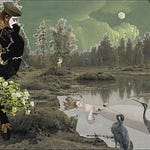XIX. PAPILLONS NOIRSDe sinistres papillons noirs Du soleil ont éteint la gloire, Et l’horizon semble un grimoire Barbouillé d’encre tous les soirs.
Il sort d’occultes encensoirs Un parfum troublant la mémoire : De sinistres papillons noirs Du soleil ont éteint la gloire.
Des monstres aux gluants suçoirs Recherchent du sang pour le boire, Et du ciel, en poussière noire, Descendent sur nos désespoirs De sinistres papillons noirs.
XIX. BLACK MOTHSSome sinister black moths have extinguished the sun’s glory, and the horizon resembles a book of spells bedaubed with black ink every evening.
There floats out of hidden thuribles an odor bearing confusion to the memory: some sinister black moths have extinguished the sun’s glory.
Monsters with sticky suckers are searching for blood to drink, and from the sky, as a black dust, there descend onto our despairs some sinister black moths.
NOTES
1 This is the fourth rondel in RM1883, where it has the same title.PAPILLONS : The folk distinction that English makes between moths and butterflies (which has little or no scientific justification), disjoint groups which together cover all lepidopterans, has never been established in French: papillon refers indifferently to both.
3 gloire : See XIX.12.
4 grimoire : « Livre dont on dit que les magiciens se servent pour évoquer les démons, etc. », ‘Book which is said to be used by magicians to evoke demons, etc.’. The current (9th) edition of DAf adds an etymological note: « XIVe siècle, grymoire. Altération de gramaire, ancienne forme de grammaire, pris au sens de ‹ livre de magie ›, parce qu’au Moyen Âge les grammaires, écrites en latin, étaient incompré- hensibles au vulgaire », “15th century, grymoire. Variant of gramaire, ancient form of grammaire, ‘book of magic’, since in the Middle Ages grammar books, written in Latin, were incomprehensible to common people.”
5 barbouillé d’encre : In all editions of DAf through 1878, the first principal definiens for barbouiller is « Salir », ‘to soil’; through 1878, the second is « Peindre grossiere- ment de quelque couleur, avec une brosse », ‘To paint crudely in some color, using a brush’ (promoted to first in DAf1935). From 1718 through 1878, the default color of encre, ‘ink’, is noire, ‘black’.
7 parfum : [NOTE IN PROGRESS]troublant : XVIII.3, XIX.6, XXVI.12, XXIX.3, XXXII.4.
12 poussière noire : Black dust. Both the literal and figurative semantics of French poussière align remarkably closely with those of English dust (e.g., every edition of DAf has included the idiom mordre la poussière, literally bite the dust, assigning it the identical figurative meaning to that English phrase; and similarly with allusive references to mortality, to dry scholarship, etc.). Belgian French is particularly blessed with phrasal idioms using the word: 7 of the 10 such documented in BDLP are Belgian, including cache-poussière (dustcoat [British English]), loque à poussière (dust cloth), and faire-poussières (to dust, in the sense of housework). Giraud’s three uses of poussière, here and in rondels XLI and XLIX, are all more or less literal (although each does specify a color for the dust: black, pink, and bluish, respective- ly) and in no way idiomatic; given the high background dust-consciousness of his speech community, it seems unreasonable to draw any conclusions about his poetic motivations for those uses—he may just be painting a homely picture.









Share this post